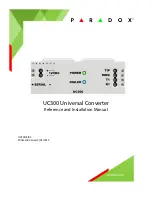
5.4. Alarms
The SmartShunt can raise an alarm on low state of charge, low or high battery
voltages readings, low or high temperature readings or a certain midpoint deviation.
The alarm will activate when the value reaches a set threshold and will deactivate
once when the value clears this threshold.
The alarm is a software alarm. When connecting with the VictronConnect App and an
alarm is active, the alarm will show in the App. Or, alternatively, when the SmartShunt
is connected to a GX device the alarm will show up on the GX device or on VRM.
In case of VictronConnect an alarm is acknowledged when a button is pressed. And in
a GX device an alarm is acknowledged when viewed in notifications. However, the
alarm icon is displayed as long as the alarm condition remains.
Please note that unlike the BMV battery monitor range, the SmartShunt does not have
an alarm relay or buzzer. In case a relay function is needed, connect the SmartShunt
to a GX device and use the relay in the GX device with SmartShunt functionality.
5.5. History data
The SmartShunt stores historic events. These can be used at a later date
to evaluate usage patterns and battery health. The history can be
accessed in the “History” tab in VictronConnect. The history data is
stored in a non-volatile memory and will not be lost when the power
supply to the SmartShunt has been interrupted or when the SmartShunt
has been reset to its defaults.
Discharge information in Ah
• Deepest discharge: The SmartShunt remembers the deepest
discharge and each time the battery is discharged deeper the old value
will be overwritten.
• Last discharge: The SmartShunt keeps track of the discharge during
the current cycle and displays the largest value recorded for Ah
consumed since the last synchronisation.
• Average discharge: The cumulative Ah drawn divided by the total
number of cycles.
• Cumulative Ah drawn - The cumulative number of Amp hours drawn
from the battery over the lifetime of the SmartShunt.
Energy in kWh
• Discharged energy: This is the total amount of energy drawn from the
battery in (k)Wh.
• Charged energy: The total amount of energy absorbed by the battery
in (k)Wh.
Charge
• Total charge cycles: The number of charge cycles over the lifetime of the SmartShunt. A charge cycle is counted every time the
state of charge drops below 65% and then rises above 90%.
• Time since last full charge: The number of days since the last full charge.
• Synchronisations: The number of automatic synchronisations. A synchronisation is counted every time the state of charge
drops below 90% before a synchronisation occurs.
• Number of full discharges: The number of full discharges. A full discharge is counted when the state of charge reaches 0%.
Battery voltage
• Min battery voltage: The lowest battery voltage.
• Max battery voltage: The highest battery voltage.
• Min starter voltage: The lowest auxiliary battery voltage (if applicable).
• Max starter voltage: The highest auxiliary battery voltage (if applicable).
Voltage alarms
• Low voltage alarms: The number of low voltage alarms.
Manual - SmartShunt
Page 14
Operation
















































